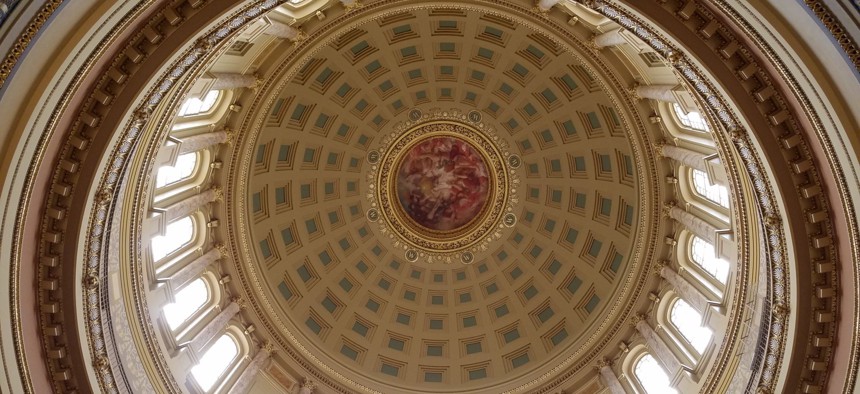Route Fifty Roadmap: Exploring Wisconsin’s State Capitol Building

In the Rotunda of the Wisconsin State Capitol Michael Grass / RouteFifty.com
The Badger State’s current seat of government was born out of a mixture of disaster, bad luck and hubris.
Route Fifty Roadmap is an ongoing series of dispatches from the semi-regular travels of the Route Fifty staff around the United States | PREVIOUSLY: Concord, N.H.
MADISON, Wis. — While it’s difficult to quantify which U.S. state capitol building is the most aesthetically majestic, it’s hard to deny that Wisconsin’s seat of government is among the most beautiful in America, with its ornate rotunda and giant dome that dominates the skyline of the Badger State’s capital city.
This past week, I took a tour of the grand building, and got to see the Governor’s Conference Room and the Assembly, Senate and Supreme Court chambers. I also climbed to the dome’s exterior balcony, which offers breathtaking views of Madison and the two lakes the city is nestled between, Mendota and Monona.
Completed in 1917, the Wisconsin State Capitol—the third to stand in Capitol Square—was born out of a mixture of disaster, bad luck and hubris. On Feb. 27, 1904, a small fire started in a cloakroom with a newly varnished ceiling and it quickly spread throughout the structure, hampered by inadequate firefighting equipment.

Because the building had an advanced $20,000 sprinkler system, the fire should have been quickly contained. But it wasn’t.
As The Capital Times explained on the fire’s 100th anniversary:
The system was supplied by a large vat of water, which was beneath the dome on what was then called Main Hall on the University of Wisconsin campus. The problem was, university engineers drained the huge container while they did boiler repairs.
Still, that should have been only a temporary problem. As the city's superintendent of water works, John B. Heim, would later explain, the city water main around the Capitol connected to the Capitol system on the inside of the park in front of Kornhauser's store on West Mifflin Street. But the connection was made only when someone turned the valve. Nobody did, Heim said, or the disaster would have been averted.
To make matters worse, my tour guide told our group, members of the Wisconsin Legislature, who had high confidence in the sprinkler system, had let the fire insurance policy for the Capitol lapse.
Wisconsin’s Capitol, would, naturally, be rebuilt. And the structure that rose from the ashes would become an edifice far more impressive than what it replaced. And if you’re visiting Madison, the Capitol is certainly worth a visit.





Michael Grass is Executive Editor of Government Executive’s Route Fifty and is based in Seattle.
NEXT STORY: Is No-Fault Auto Insurance to Blame for High Rates, Fraud?






